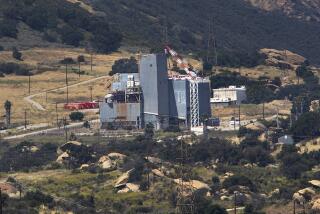Contamination Tags Along to New Home : Environment: Woman who fled Love Canal in the 1970s discovers her Connecticut residence is sitting near a toxic dump.
- Share via
STRATFORD, Conn. — Jeanne Lostracco thought she’d left behind the dread of living near a toxic waste site when she moved from Love Canal 14 years ago.
But in May, Lostracco learned she had a new reason to worry: Her home is two blocks from a site where dangerously high levels of asbestos, lead and PCBs have been found.
“We saw it on TV, and I said, ‘You’re kidding me. This can’t be happening,’ ” Lostracco said.
At least eight contaminated sites are spread across town, including a public baseball diamond, a boat club, and playing fields at Wooster Middle School.
“One of the reasons we bought this house is because it’s a nice area. The school is right there, and we were going to send my daughter there,” Lostracco said. “At this point, we don’t know what to do.”
The toxins came from a brake lining plant, Raymark Industries, which sold or gave away contaminated sludge for fill between the 1950s and 1970s.
Lostracco, 34, grew up in Niagara Falls, N.Y., just a block from the Love Canal dump, the nation’s most notorious chemical landfill. Her family was one of hundreds evacuated in the late 1970s when a health emergency was declared because of contamination.
Lostracco’s family moved to Connecticut. She and her husband, David, bought a house three years ago in Stratford, a community of 49,000, about 15 miles southwest of New Haven.
Lostracco’s father, who suffered from lupus and various lung ailments, died last July at age 57. Lostracco is convinced his health problems were caused by his exposure to chemicals at Love Canal.
She has suffered from seizures for 10 years, has a thyroid disorder and had three miscarriages before giving birth to her daughter, Megan, four years ago. She quit her job as a bookkeeper because the seizures made driving dangerous.
Now, Lostracco is worried that she and her family could be facing new health risks.
“I don’t think this compares in any way to Love Canal, but I’m concerned,” she said. “Everything is still just wait and see.”
Federal and state officials toured three of the waste sites recently.
“We recognize that some very serious health concerns have been identified . . . and we want to stress to you that we will be here for the long haul,” said Robert Sussman, deputy administrator of the Environmental Protection Agency.
Health officials have recommended that children under age 6 and pregnant women who might have been exposed to the sites get tested for lead poisoning. Megan’s test came back negative.
Lead exposure has been shown to decrease intelligence scores, slow growth and cause hearing problems in young children. Transfer of lead to a fetus can cause premature birth, low birth weight and neurological damage.
The extent of the contamination was made public in May after tests showed high levels of asbestos, lead and polychlorinated biphenyls at eight of 16 known sites where waste was deposited.
Other test results aren’t yet completed. The contaminated sites have been closed.
State officials are covering the contaminated sites with temporary fill, and say they plan to permanently cap them. More than $8 million in state and federal funds have been pledged.
Environmental officials say it is way too early to tell whether families will have to relocate.
Lostracco fears that, like Love Canal, the contamination will turn out to be worse than originally thought.
Paul Keough, regional EPA administrator, said the contamination does not appear to be of the same magnitude as Love Canal.
“In Love Canal, you had liquid waste coming in people’s basements,” he said. “There’s no comparison.”
More to Read
Sign up for Essential California
The most important California stories and recommendations in your inbox every morning.
You may occasionally receive promotional content from the Los Angeles Times.










